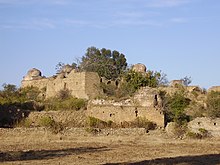Hindu temple
From Wikipedia, the free encyclopedia

Frontal-right view of the Brihadeshwara temple
| |
Nomenclature, orthography and etymology
Lots of Hindu temples are known by different names in different parts of the world, depending upon the language. The word mandir or mandira is used in many languages, including Hindi, and is derived from a Sanskrit word, mandira, for 'house' (of a deity by implication). Temples are known as Gudi, Devalayam or Kovela in Telugu, as Devasthana or Gudi in Kannada and Mondir (মন্দির) in Bengali, as Kshetram or Ambalam in Malayalam. Temples are known as kō-yil - கோயில் (and occasionally, especially in modern formal speech, aalayam - ஆலயம்) in Tamil. The etymology is from kō - கோ, or lord, and il - இல் - home (note that besides meaning a deity's home, this term could also mean a King's home, since the term kō - கோ is used interchangeably for royalty and divinity).History

The Akshardham temple in Delhi is the largest comprehensive Hindu temple complex, according to Guinness World Records.
North Indian Temples

Tilla Jogian, Pakistan.
[edit] South Indian Temples

Temple in Kerala

Balaji temple of Tirupati
Temples in other parts of India
Temples often greatly vary in their appearance, rituals, traditions, festivals and customs from region to region. Temples in eastern and western India also have their distinctions. In the south, kerala temples are very different from temples in the other three states.Temples in West Bengal & Bangaladesh
.In West Bengal & Bangaladesh, temple architecture has assumed a unique identity. Due to lack of suitable stone in the alluvial Gangetic delta, the temple makers had to resort to other materials instead of stone. This gave rise to using terra cotta as a medium for temple construction. Terra-cotta exteriors with rich carvings are a unique feature of Bengali temples. The town of Vishnupur in West Bengal is renowned for this type of architecture.
Usually a part of the intended total motif was carved by hand on one side of a brick and then baked. While under construction, these carved bricks were arranged to make up the entire motif.
The Bengali style of temple is not luxurious. Rather, most are modeled on simple thatched-roof earthen huts used as dwellings by commoners. This can be attributed to the popularity of bhakti cults which taught people to view gods as close to themselves. Thus, various styles like do-chala, char-chala, and aat-chala sprang up. However, there is also a popular style of building known as Navaratna (nine-towered) or Pancharatna (five-towered) in Bengal which is more luxurious than the Chala buildings. A typical example of Navaratna style is the Dakshineswar Kali Temple.
Customs and etiquette

An aerial view of the Angkor Wat Temple complex in Cambodia
Visitors and worshipers to Hindu temples are required to remove shoes and other footwear before entering them. Most temples have an area designated to store footwear.
The Hindu religion teaches that all life-forms are created by Brahma and that humankind needs to share the world with the animal kingdom. It is common to see stray dogs, sacred cows and various species of birds congregated at temples.
Worshipers in major temples typically bring in symbolic offerings for the prayer or 'puja'. This includes fruits, flowers, sweets and other symbols of the bounty of the natural world. Temples in India are typically surrounded by small stores called 'dukan' (Hindi) which offer them typically wrapped in organic containers such as banana leaves.
When inside the temple, it is typical to keep both hands folded together as a sign of respect. The worshipers approach the inner sanctum, recite sacred Sanskrit verses called 'mantras', follow the instructions of the priest called the 'pujari', meditate & pray called 'puja', and, present the offerings to the feet of the God-form 'the murthy' symbolising total submission and immersion into the All Loving Being. The 'murthy' is typically placed on a 'mandap' or pedestal surrounded by beautiful offerings such as colorful cloths, flowers, incense sticks or 'agarbati' and sounds such as from a conch or large bells.
The mantras spoken are typically "Om Namo Narayana" or "Om Namah Shivaya" which mean "Obeisance to Narayana( vishnu)" or "Salutations to Shiva". These are followed by a series of shlokas or verses from the holy texts such as the Bhagavad Gita, Upanishads or Vedas. Upon the conclusion of the prayer, devotees get down on their knees or even fall flat on their stomach and bow before the symbol of the deity. If a priest or 'Pujari' is present, he is likely to provide sacred symbolically-blessed food called 'Prasad' to the devotee. He may also apply a holy red mark called ' Tilak ' to the forehead of the devotee symbolising blessings.
Finally the worshiper or visitor would walk clock-wise around the sanctum sanctorum , stop once on each side, close their eyes and pray to the All Loving Being. The worshipper may receive a sprinkling of the water from the holy river Ganges while the 'pujari' states "Om Shanti" which means "peace be unto all".
During religious holidays, temples may be swarmed with devotees chanting and praying loudly. There may be facilitators called 'paandaas' who help visitors navigate through the crowds and complete the 'puja' or prayer rituals quickly.
Temple management staff typically announce the hours of operation, including timings for special 'pujas'. For example the 'anjali' prayers are in the early-to-mid morning while 'arati' prayers are in the evening. There are also timings for devotional songs or music called bhajans,which are accompanied by a Dholak or Tabla soloist an/or Harmonium soloist. There are also dates and times for devotional dances such as the classical Bharata Natyam dance performed by accomplished dance performers.
The Hindu religion teaches propitiation of those who might have reason to cast the 'evil eye' - namely the poor and weak who swarm around the doors of the temples. At the exit areas of the temples worshipers or visitors often distribute Prasad and give out spare change to beggars, mentally or physically challenged individuals, and destitute women and children. Transgendered people often curse the progeny of those who refuse alms to suffer the same fate - something frantically feared by a largely superstitious population.
Management
The Archeological Survey of India has control of most ancient temples of archaeological importance in India.In India, theoretically, a temple is managed by a temple board committee that administers its finances, management and events.
However since independence, the autonomy of individual Hindu religious denominations to manage their own affairs with respect to temples of their own denomination have been severely eroded. State governments of many states in India (and especially all the states in South India) have gradually increased their control over all Hindu temples. Over decades, by enacting various laws which have been fought both successfully and unsuccessfully up to the Supreme court of India, politicians of the ruling parties especially in the southern states control every aspect of temple management and functioning.








